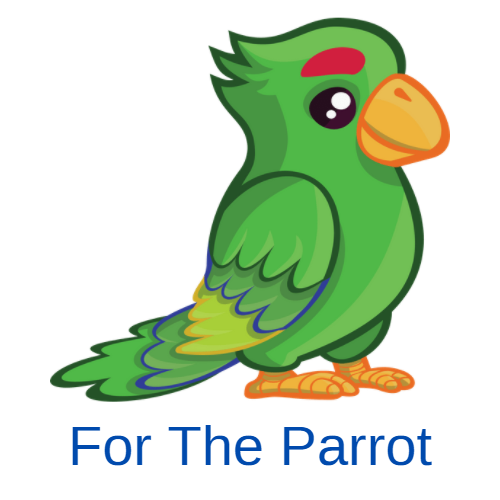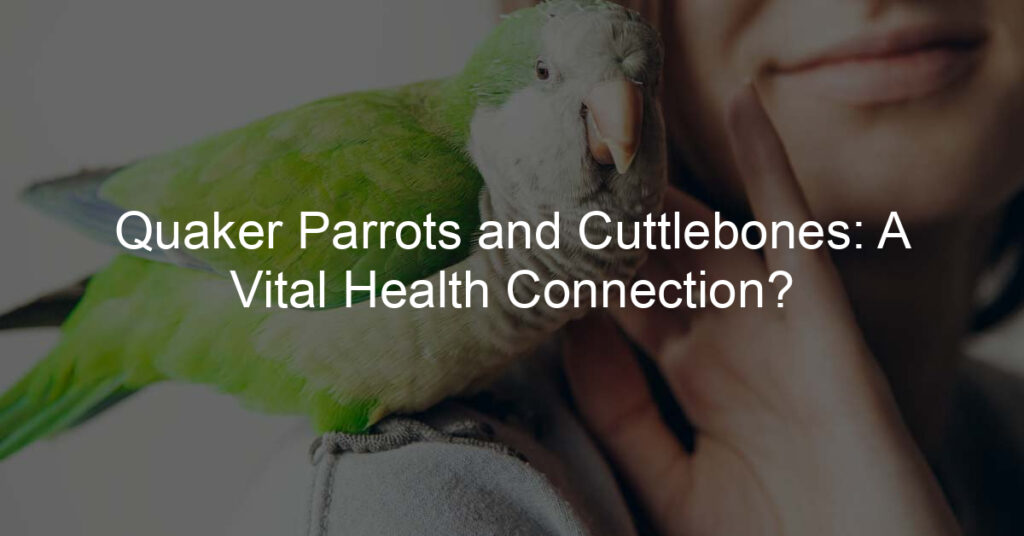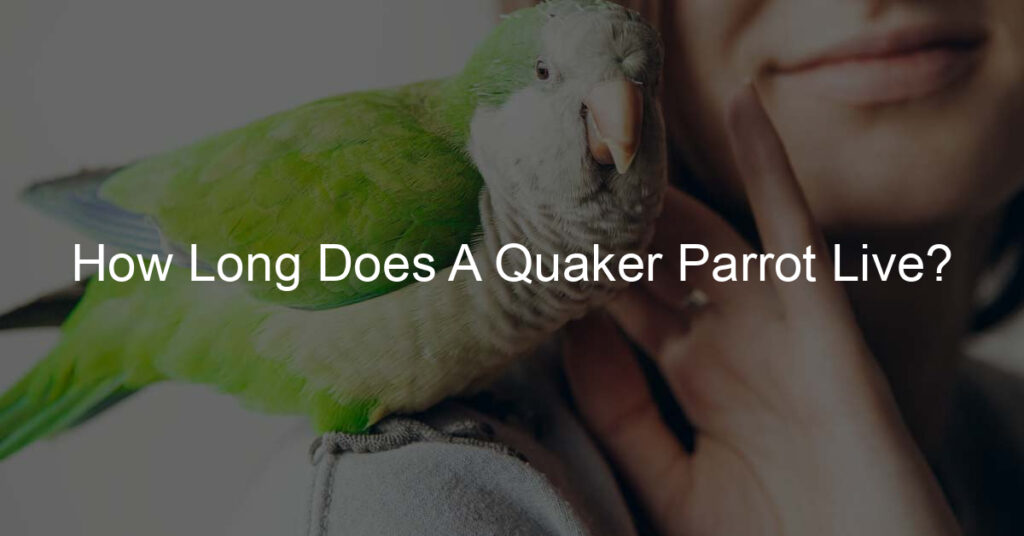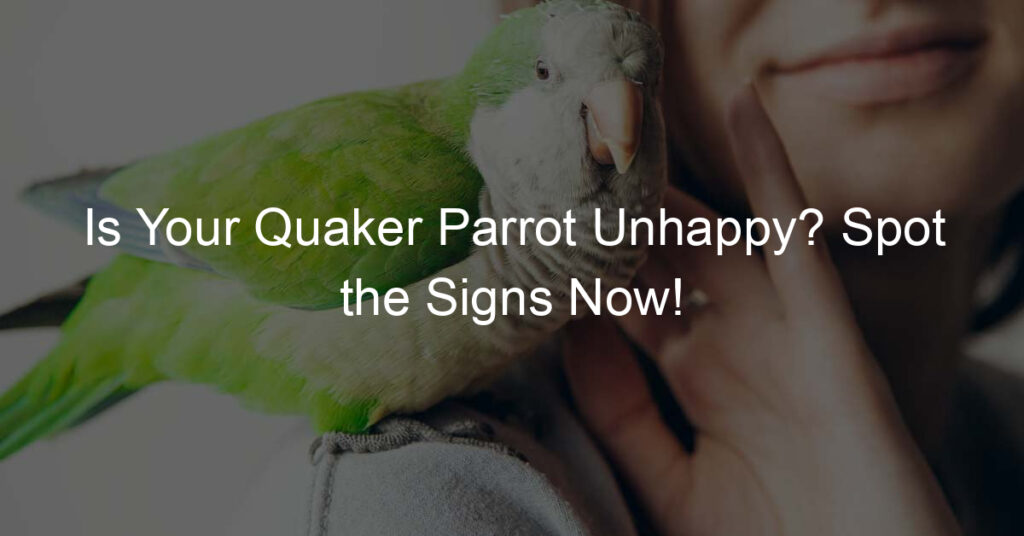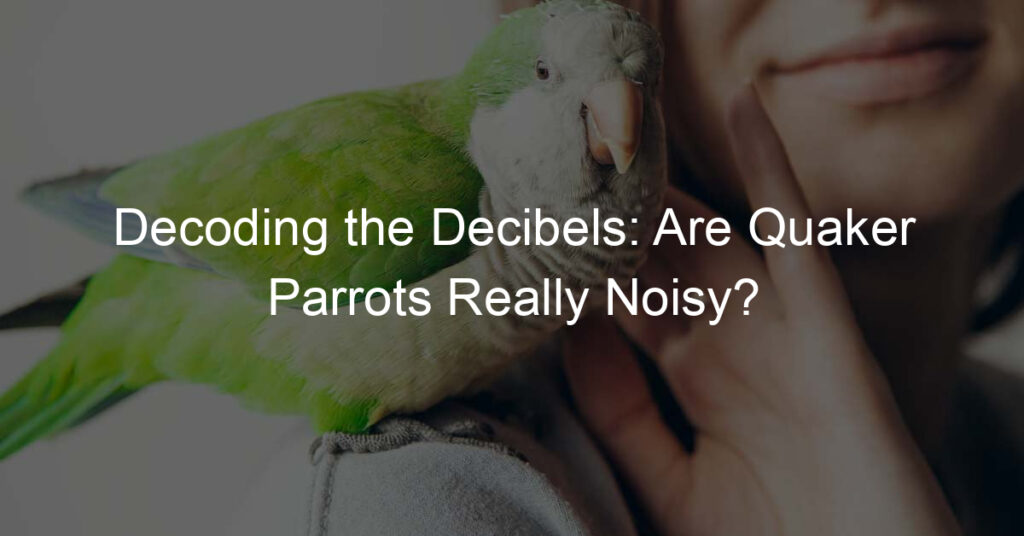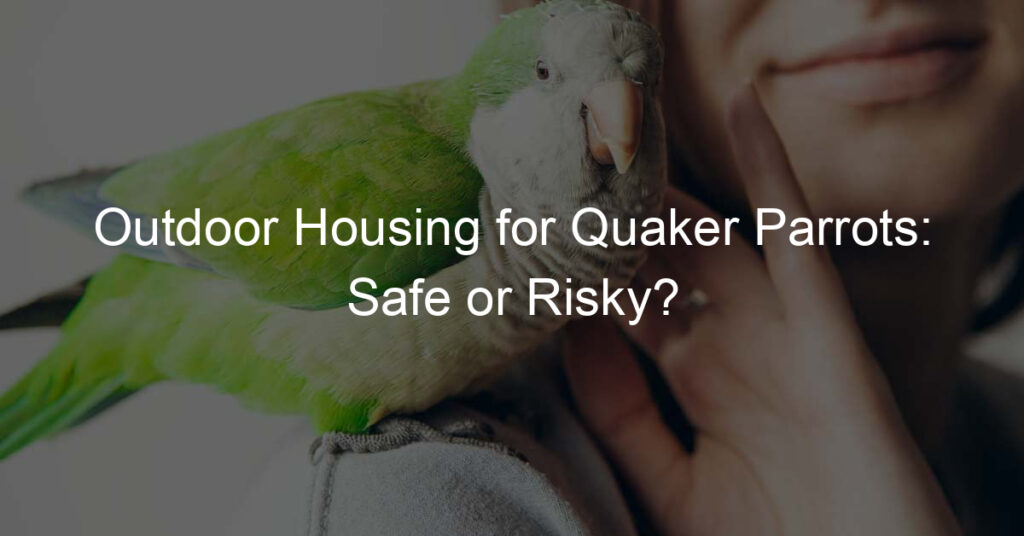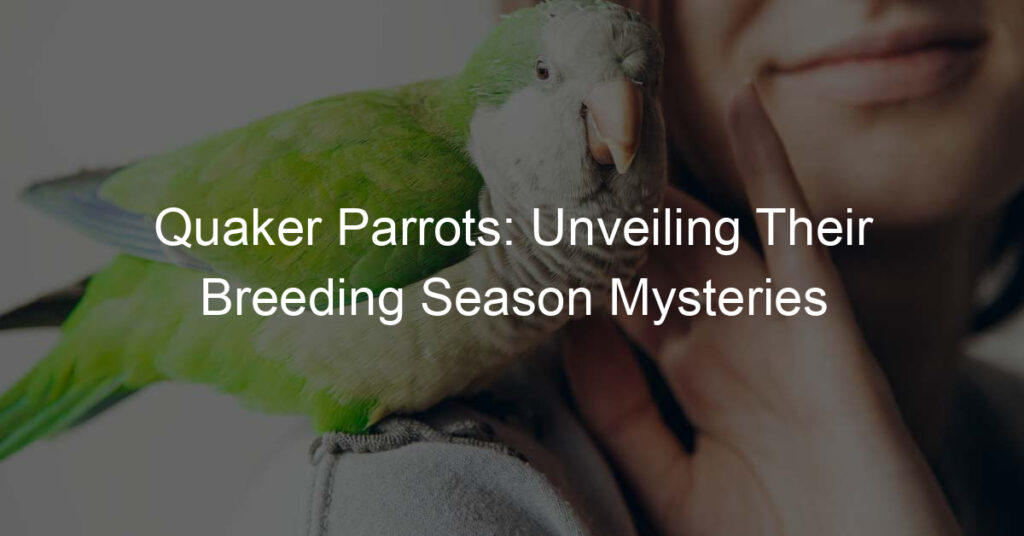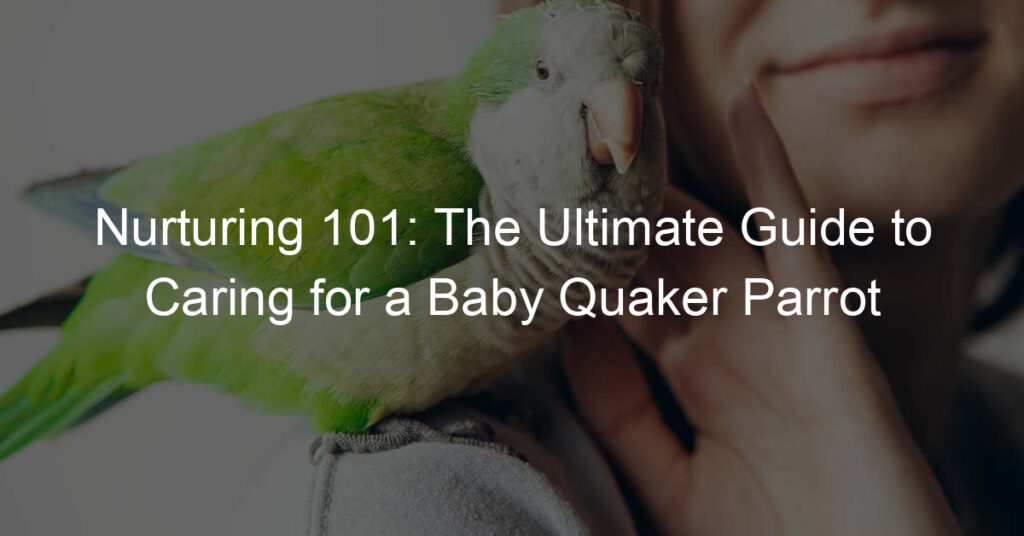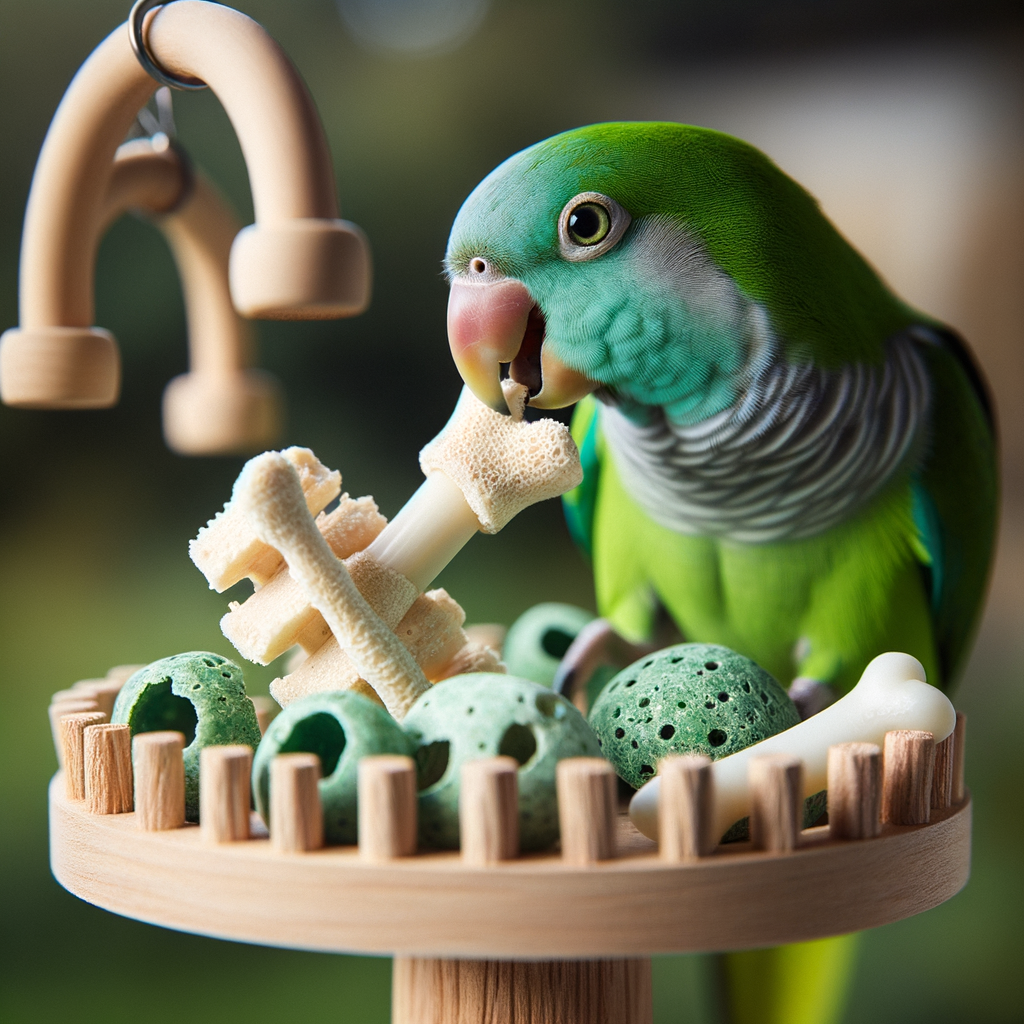
Introduction to Quaker Parrots
Welcome to our comprehensive guide about Quaker Parrots. These vibrant and intelligent birds are a joy to have as pets, and understanding them better can help you provide the best care for them.
-
Overview of Quaker Parrots
Quaker Parrots, also known as Monk Parakeets, are small, bright-green birds native to South America. They are known for their distinctive ‘quaker’ or ‘shaking’ movements, which is how they got their name. Quaker Parrots are popular pets due to their sociable nature, intelligence, and ability to mimic human speech.
These birds are about 11-12 inches long and weigh around 3-5 ounces. They have a lifespan of 20-30 years in captivity, which means owning a Quaker Parrot is a long-term commitment.
Quaker Parrots are known for their strong personalities. They are active, curious, and love to play. They also have a strong instinct to build nests, which is unique among parrot species.
-
Quaker Parrots in the wild vs. in captivity
In the wild, Quaker Parrots live in large colonies and build complex nests in trees. They feed on a variety of fruits, vegetables, seeds, and insects. Their ability to adapt to different environments has allowed them to establish wild populations in several countries outside their native range.
In captivity, Quaker Parrots require a balanced diet similar to what they would eat in the wild, along with plenty of mental and physical stimulation. They need social interaction and enjoy being part of family activities. Providing them with toys and opportunities for exercise is essential for their well-being.
It’s important to note that owning a Quaker Parrot is illegal in some states due to their potential to disrupt local ecosystems if they escape and establish wild colonies. Always check local regulations before deciding to get a Quaker Parrot as a pet.
Stay tuned as we delve deeper into the diet, health needs, and care of Quaker Parrots in the following sections.
Understanding Quaker Parrots Diet
Quaker parrots, also known as monk parakeets, are vibrant and intelligent birds that require a specific diet to ensure their health and longevity. Let’s delve into the typical diet of these fascinating creatures and understand why a balanced diet is crucial for their wellbeing.
- Typical diet of Quaker Parrots
- Importance of a balanced diet for parrot health
Quaker parrots are omnivores, meaning they eat both plants and meat. Their diet in the wild consists mainly of fruits, vegetables, seeds, and insects. In captivity, a balanced diet for a Quaker parrot should include a variety of fresh fruits and vegetables, high-quality bird pellets, and a limited amount of seeds and nuts. Foods like apples, carrots, peas, and corn are excellent choices. It’s also important to provide them with a source of protein, such as cooked chicken or hard-boiled eggs.
A balanced diet is vital for a Quaker parrot’s health. Just like humans, these birds need a mix of nutrients to stay healthy. A diet that is too heavy on seeds can lead to obesity and other health problems. On the other hand, a diet lacking in fruits and vegetables can cause vitamin and mineral deficiencies. Therefore, it’s essential to provide a variety of foods to ensure they get all the necessary nutrients.
Remember, every bird is unique and may have different dietary needs. Always consult with a vet or a bird nutrition expert to create a diet plan that suits your Quaker parrot’s specific needs. By understanding and providing a balanced diet, you can help your feathered friend live a long, healthy, and happy life.
Role of Cuttlebones in Bird Nutrition
When it comes to bird nutrition, especially for our Quaker parrots, cuttlebones play an essential role. But what are cuttlebones, and why are they so important? Let’s explore.
- What are Cuttlebones?
- Nutritional content of Cuttlebones
- Benefits of Cuttlebones for parrots
Cuttlebones are not actually bones, but the internal shell of the Cuttlefish, a type of squid-like creature. They are lightweight, chalky, and packed with essential nutrients. Cuttlebones are commonly used as a dietary supplement for birds, particularly parrots.
Cuttlebones are rich in calcium, which is vital for the health of birds. They also contain trace amounts of other minerals such as magnesium, potassium, and zinc. Here’s a simple table to illustrate:
| Nutrient | Amount |
|---|---|
| Calcium | 85% |
| Magnesium | 1% |
| Potassium | 0.2% |
| Zinc | 0.1% |
These nutrients are essential for the overall health and well-being of our feathered friends.
Cuttlebones offer a range of benefits for parrots. The high calcium content helps in the formation of strong bones and feathers. It also plays a crucial role in egg formation for female parrots. Additionally, gnawing on the cuttlebone helps keep the parrot’s beak in good shape. It’s a natural, beneficial addition to any parrot’s diet.
In conclusion, cuttlebones are a vital part of a parrot’s diet, providing essential nutrients and health benefits. So, next time you see your parrot nibbling on a cuttlebone, remember, it’s not just a toy, but a crucial part of their nutrition.
Quaker Parrots and Cuttlebones: A Vital Health Connection?
Quaker parrots, also known as Monk parakeets, are vibrant, social birds that require a balanced diet for optimal health. One essential component of their diet is the cuttlebone, a supplement that provides numerous health benefits. Let’s explore why cuttlebones are so important for these fascinating birds.
Importance of Cuttlebones in Quaker Parrots Diet
Cuttlebones are not just a toy for your Quaker parrot to peck at. They are a vital source of nutrients that contribute to the overall health and well-being of your bird. Here are two key reasons why cuttlebones should be included in your Quaker parrot’s diet:
- Calcium and mineral benefits
- Beak health and maintenance
Cuttlebones are rich in calcium, a mineral that is crucial for the health of Quaker parrots. Calcium helps in the formation of strong bones and feathers. It also plays a vital role in egg formation for female parrots. Besides calcium, cuttlebones also contain trace amounts of other minerals like magnesium, potassium, and zinc, which are beneficial for your bird’s health.
Chewing on a cuttlebone is a natural way for Quaker parrots to keep their beaks trimmed and sharp. This is important because a parrot’s beak grows continuously, much like our fingernails. If the beak becomes too long, it can interfere with the bird’s ability to eat. Regular access to a cuttlebone can help prevent this problem.
In conclusion, cuttlebones play a vital role in the diet of Quaker parrots, contributing to their overall health and well-being. By including a cuttlebone in your bird’s cage, you are ensuring that they receive the necessary calcium and minerals they need, while also helping maintain their beak health.
How to Introduce Cuttlebones to Quaker Parrots
Introducing cuttlebones to your Quaker parrot’s diet is a crucial step in ensuring their optimal health. The process involves two main steps: choosing the right cuttlebone and finding the best method to introduce it.
- Choosing the Right Cuttlebone
- Methods of Introducing Cuttlebones
Not all cuttlebones are created equal. When selecting a cuttlebone for your Quaker parrot, consider its size, shape, and quality. The cuttlebone should be large enough for your parrot to comfortably peck at, but not so large that it becomes a choking hazard. The shape should be easy for your parrot to grip and manipulate. As for quality, look for cuttlebones that are clean, white, and free of cracks or other visible defects. Remember, the healthier the cuttlebone, the more benefits it will provide to your parrot.
Once you have the right cuttlebone, the next step is introducing it to your Quaker parrot. There are several methods you can use, but the most effective ones involve gradual introduction and positive reinforcement.
Start by placing the cuttlebone in a location where your parrot can easily see and access it. Let your parrot observe the cuttlebone for a few days without forcing interaction. This allows your parrot to become familiar with the new object in its environment.
Next, encourage your parrot to interact with the cuttlebone. You can do this by demonstrating how to peck at the cuttlebone or by placing some of your parrot’s favorite treats near it. Positive reinforcement, such as praise or additional treats, can also help motivate your parrot to use the cuttlebone.
Remember, patience is key. It may take some time for your Quaker parrot to start using the cuttlebone regularly, but the health benefits it provides are well worth the wait.
Quaker Parrots Health Needs
Quaker parrots, also known as Monk Parakeets, are vibrant, intelligent birds that make great pets. However, like all living creatures, they have specific health needs that must be met to ensure they live a long and healthy life. Let’s explore some of the common health issues in Quaker parrots and the role of diet in preventing these issues.
- Common health issues in Quaker Parrots
- Psittacosis: This is a bacterial infection that can cause respiratory problems, diarrhea, and loss of appetite.
- Feather plucking: This is often a sign of stress, boredom, or nutritional deficiencies.
- Beak and feather disease: This viral infection can lead to abnormal feather growth and beak deformities.
- Fatty liver disease: This is often caused by a diet high in fat and low in nutrients.
- Role of diet in preventing health issues
- Fruits and Vegetables: These should make up a large portion of your parrot’s diet. They provide essential vitamins and minerals that can help boost the immune system and prevent disease.
- Seeds and Nuts: While these are a favorite of many parrots, they should be given in moderation as they are high in fat.
- Pellets: These are often a good choice as they are nutritionally balanced.
Quaker parrots can suffer from a variety of health issues. Some of the most common include:
While these are some of the most common health issues, it’s important to remember that each bird is unique and may experience different health problems.
The diet of a Quaker parrot plays a crucial role in its overall health. A balanced diet can help prevent many of the common health issues mentioned above.
Remember, a healthy diet is one of the best ways to prevent health issues in your Quaker parrot. Always consult with a vet to ensure your bird is getting the nutrients it needs.
Quaker Parrots Care
When it comes to taking care of Quaker parrots, creating a healthy environment is of utmost importance. This involves maintaining a clean habitat and providing mental and physical stimulation for your feathered friend.
Creating a Healthy Environment for Quaker Parrots
Quaker parrots, like all pets, thrive in a well-kept environment that caters to their physical and mental needs. Let’s delve into the two key aspects of creating such an environment.
- Importance of a clean habitat
- Providing mental and physical stimulation
Keeping your parrot’s habitat clean is crucial for its health. Dirty cages can harbor harmful bacteria and parasites, which can lead to various health issues. Regularly clean the cage, food and water dishes, and replace the cage liner frequently. Also, ensure the cage is dry as dampness can breed fungus and bacteria. Remember, a clean habitat is a healthy habitat.
Quaker parrots are intelligent and active birds. They need plenty of mental and physical stimulation to stay happy and healthy. Provide a variety of toys for them to play with and rotate them regularly to keep their interest. Also, ensure they have enough space to fly and exercise. Interaction is also key, so spend time playing and talking with your parrot. This not only keeps them mentally stimulated but also strengthens your bond with them.
In conclusion, taking care of a Quaker parrot involves more than just providing food and water. It requires dedication to ensure they live in a clean, stimulating environment. By doing so, you can ensure your feathered friend stays happy, healthy, and vibrant.
Regular Health Check-ups for Quaker Parrots
Just like us humans, our feathered friends, the Quaker Parrots, also need regular health check-ups to ensure they are in the best of health. Regular vet visits and being aware of signs of health issues are crucial for their well-being.
- Importance of Regular Vet Visits
- Signs of Health Issues to Watch For
Regular vet visits are a cornerstone of your Quaker Parrot’s health. These visits allow the vet to monitor your parrot’s health and catch any potential issues early. According to the Association of Avian Veterinarians, parrots should have a check-up at least once a year. During these visits, the vet will typically check the bird’s weight, examine its feathers, beak, and eyes, and may also perform blood tests. Regular vet visits can help ensure your Quaker Parrot lives a long, healthy life.
As a Quaker Parrot owner, it’s essential to be aware of signs that your bird may be unwell. Some common signs of health issues in parrots include changes in eating or drinking habits, weight loss, changes in droppings, and unusual behavior such as lethargy or aggression. If you notice any of these signs, it’s important to take your bird to the vet as soon as possible. Early detection and treatment can make a significant difference in your parrot’s health.
In conclusion, regular health check-ups and being vigilant about signs of health issues are vital for your Quaker Parrot’s well-being. Remember, a healthy parrot is a happy parrot!
Conclusion: The Vital Role of Cuttlebones in Quaker Parrots Health
In this article, we have delved into the fascinating world of Quaker Parrots, their dietary needs, and the importance of cuttlebones in their nutrition. As we conclude, let’s recap the key points and share some final thoughts on Quaker Parrots’ care and nutrition.
- Recap of the benefits of Cuttlebones
- Final thoughts on Quaker Parrots care and nutrition
Cuttlebones play a crucial role in the health of Quaker Parrots. They are a rich source of calcium, a mineral that is essential for the development and maintenance of strong beaks and bones. Cuttlebones also help in digestion and in the production of healthy feathers. They serve as a fun and engaging tool for parrots, helping to keep their beaks sharp and their minds stimulated.
Quaker Parrots, like all pets, require a balanced diet and proper care to thrive. Their diet should be varied and include a mix of seeds, fruits, vegetables, and of course, cuttlebones. Regular vet check-ups are also important to monitor their health. Remember, a healthy parrot is a happy parrot. By providing the right nutrition and care, you can ensure your Quaker Parrot lives a long, healthy, and happy life.
In conclusion, the role of cuttlebones in the health of Quaker Parrots cannot be overstated. They are not just a supplement but a necessity. So, next time you see a cuttlebone, remember, it’s not just a bone, it’s a lifeline for your Quaker Parrot.
